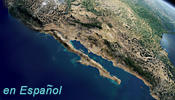![[Ocean Oasis Field Guide]](images/bnr-oo-field.gif)

![[Ocean Oasis Field Guide]](images/bnr-oo-field.gif) |  |
Bursera hindsiana BURSERACEAE (Torchwood Family) The generic name, Bursera, refers to J. Burser, born in the 1500s. Other members of this genus native to Baja California are Bursera cerasifolia, B. epinnata (Copal), B. fagaroides, B. laxiflora, B. filicifolia, B. odorata (Torote Blanco), and B. microphylla (Torote Colorado). Bursera hindsiana is planted in the cactus and succulent garden across Park Boulevard from the San Diego Natural History Museum in Balboa Park. DescriptionA small tree or shrub to 3.5 m (10-1/2 feet) tall. The reddish twigs and light reddish-gray trunk are smooth. The leaves are 4.5 cm (2 inches) long, simple or trifoliate, and fuzzy with scalloped margins. The flowers are 0.25 cm (1/8 inch) long, bloom from September to December, and produce an oval-shaped fruit 0.9 to1.2 centimeters (up to 1/2 inch) long. Range and HabitatCopal is found along washes and desert hillsides from near the head of the Gulf to the Cape Region, including Tiburón Island and coastal Sonora. Natural HistoryThe seeds have been used as a food source, but only in desperate times. The aromatic gum produced by the trunk is not of current commercial importance. However, a number of species within this family do produce well known commercial grade aromatic gums and balsam wood such as the genus Boswellia (frankincense) and Commiphora (myrrh). |
Text by Bob Lauri
Photographs by Norman Roberts
Field Guide |
Site Index |
Ocean Oasis Introduction
|
|
© 2000 San Diego Natural History Museum |